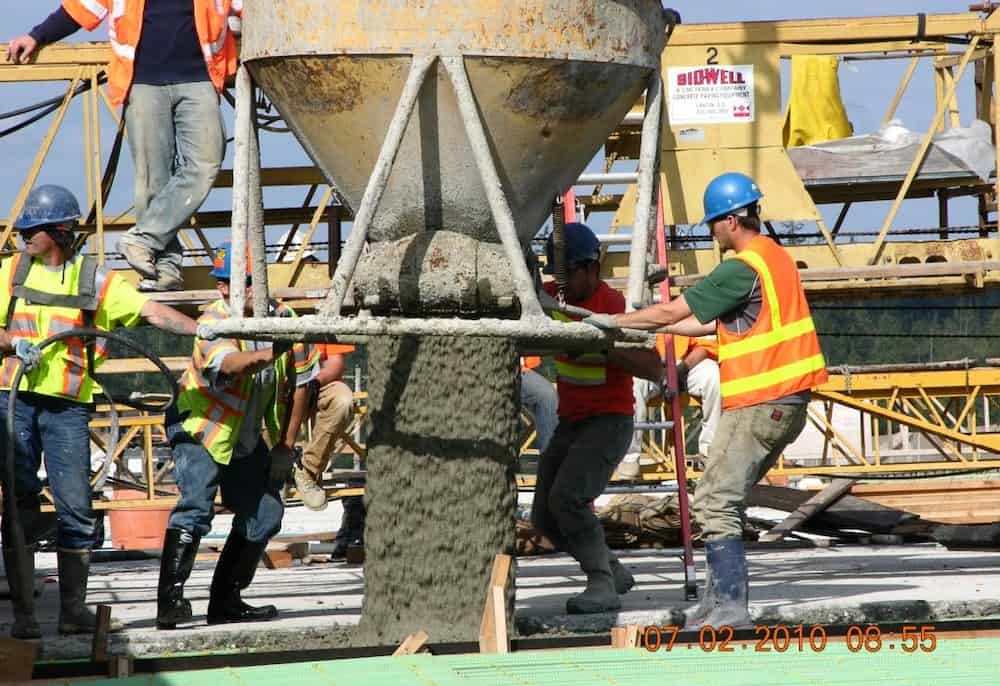
[Image above] Sulfate attack is one of the most damaging causes of concrete deterioration. Two new studies look at ways to improve concrete’s resistance to sulfate attack. Credit: Washington State Dept of Transportation, Flickr (CC BY-NC-ND 2.0)
Compared to other building materials, concrete is considered highly durable and resistant to common environmental factors, such as flooding, termites, and fire. However, concrete has its weaknesses as well, notably deterioration through sulfate attack.
Sulfates are a group of mineral salts that can have natural or human-made origins. These salts are commonly found in the soil, aggregates, sea water, and cements.
Sulfate attack on concrete occurs when water-soluble sulfates, such as alkali-earth (calcium, magnesium) and alkali (sodium, potassium) sulfates, react with aluminates or calcium hydroxide in cement paste to form crystals such as ettringite, gypsum, and thaumasite. This crystal formation leads to an increase in solid volume, resulting in expansion, cracking, and generalized deterioration of the concrete.
Sulfate attack can have both internal origins (characterized by delayed mobilization of sulfates in the cement paste) or external origins (developing from sulfates in the surrounding environment, such as the soil, groundwater, sewerage water, and sea water).
Because sulfate attack is one of the most damaging causes of concrete deterioration, much research exists on finding ways to protect against sulfate attack, such as by replacing some of the cement in concrete with alternative materials. Two new papers published this month contribute to this extensive field of research.
New geopolymer mortars enhance bond strength and durability of concrete against sulfuric acid and sulfate attack
In the first open-access paper published January 12, researchers from Saudi Arabia, Egypt, Singapore, Malaysia, and Sudan investigated the potential of new geopolymer mortars to enhance concrete’s resistance to aggressive sulfuric acid and sulfate attacks.
Geopolymer mortars are cement-free materials with numerous beneficial properties, including high strength, strong durability in aggressive environments, and less greenhouse gas emissions compared to Portland cement. They are prepared from waste materials with a high content of aluminosilicates dissolved in alkali activator solution.
There is a growing body of research on using geopolymer mortars as sustainable repair materials, with numerous studies dedicated to evaluating the mortars’ mechanical properties, such as compressive and bond strength. However, “There is a lack of information on the durability of GPMs [geopolymer mortars] as a repair material, such as compatibility between proposed mortar and concrete substrate and bond strength in aggressive environments,” the researchers of the new open-access paper write.
The researchers looked to begin filling this gap in the literature by measuring the thermal compatibility and bond strength of new geopolymer mortars based on waste ceramic tiles (WCT), fly ash (FA), and granulated blast furnace slag (GBFS). They chose this combination because “From the background, it is shown that the ternary blend content high volume WCT, FA, and GBFS activated with low sodium hydroxide molarity and sodium silicate content GPMs need to be developed.”
Based on results from a variety of tests, including thermal expansion coefficient, four-point flexural strength, and drying shrinkage, the researchers determined that geopolymer mortars composed of 50% WCT, 40% GBFS, and 10% FA can be “highly recommended” as a potential concrete repair material.
“The new findings of this research are believed to render a basis for further studies and better knowledge on the behavior of a ternary-blend GPM obtainable from the waste material in a cheap and environmentally friendly manner,” they write.
The open-access paper, published in Gels, is “Effects of sulfate and sulfuric acid on efficiency of geopolymers as concrete repair materials” (DOI: 10.3390/gels8010053).
Addition of nano alumina improves concrete’s compressive strength and resistance against sulfate attack
In the second paper made available online January 20, researchers from MIT World Peace University and REVA University in India explored partial replacement of cement with colloidal nano alumina to improve concrete’s resistance against sulfate attack.
They explain that studies by Mehta (1986) and Taylor (1997) showed that the fundamental component likely to improve the properties of concrete lies in a few nanometers. “Hence the implementation of nano technology in form of nano materials has a huge scope for concrete engineers to optimize and significantly improve the strength, durability and other important characteristics of concrete,” they write.
They summarize several studies that have explored the addition of nanomaterials to concrete, such as silica, alumina, lime, and fly ash. However, they chose to focus on nano alumina for their study because it appears to be the best at increasing compressive strength.
The researchers prepared specimens of M55 grade concrete containing varying percentages (0–5%) of colloidal nano alumina. They cured the specimens for 28 days and then tested for compressive strength and sulfate resistance using the tests IS 516–1959-Reaffirmed 2018 and ASTM C1012-04, respectively.
Results showed that addition of 2.3% nano alumina was the optimum dosage for improving strength characteristics of M55 grade concrete (compressive strength increased by 20.6% compared to M55 grade without nano alumina). The maximum sulfate resistance was also observed at 2.3% nano alumina.
The paper, published in Materials Today: Proceedings, is “Resistance against sulphate attack in concrete by addition of nano alumina” (DOI: 10.1016/j.matpr.2022.01.124).
